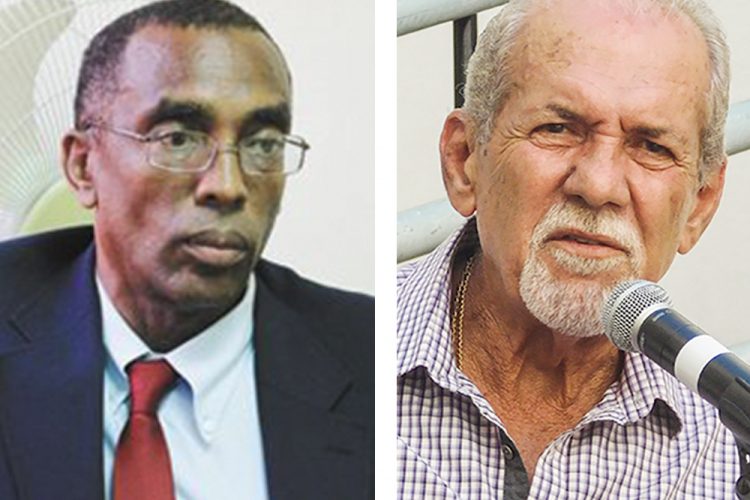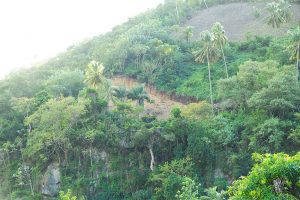Public access to the Richmond quarry EIA important – Browne

Inquiries have been coming up about the Environmental and Social Impact Assessment (ESIA) also called the Environmental Impact Assessment (EIA) attached to mining operations at Richmond.

And while former Town Planner, Bentley Browne thinks the EIA is too hard to get a hold of, Minister Senator, Julian Francis says this is not the case and the document is available for anyone who wants it.
Browne noted on Sunday that the EIA is important as it should have guided the planning application process for this project as an operation of this nature is likely to have negative impacts on the environment that must be dealt with.
Browne is a former Director of Social and Sustainable Development at the Organisation of Eastern Caribbean States (OECS) and was once the deputy director of planning in the Central Planning Division here.
He made the comments on Sunday on WE FM’s “Issue at Hand” Programme where he was a panellist speaking on the government’s move to allow the St Lucia-based firm, Rayneau Group of Companies to set up a quarry at Richmond in the North Leeward constituency.
The move has been met with push-back by some persons who farm in Richmond and live in North Leeward. They have argued that the operation has taken them by surprise and Browne says he has tried and was up to Sunday, unable to get a copy of the EIA that was done in 2008.
He said as part of the planning approval system an EIA can be accepted, refused or modifications can be asked for and noted that one of the issues being highlighted so far, a conflict over agricultural lands, is one of the things an EIA would usually highlight.
“Even though it was claimed that these documents were submitted to the planning authority it is very difficult to get hold of those documents…I don’t think the public, the media, or nobody would have seen those documents…they are hard to get…”Browne said.
SEARCHLIGHT was up to press time unable to get a copy of the EIA although on Sunday, Senator Francis said on air that the EIA was available as it is a public document.
Browne said that from experience, even though government officials said they would make the EIA available, he does not think anybody was able to access the EIA as, “the planning authority, they’re not giving you the document because as far as they are concerned the period for the public notice is over.”
In response, Minister Francis said Cabinet approved in principle, to accept the EIA/ESIA done in 2008/2009.
He noted that an advertisement was placed in the gazette and newspapers and the public can have a look at the documents because they are available.
Francis added that it took between October 14, 2021 to January 20, 2022 before an approval for the quarry was granted. He added also that persons who had objected to the quarry were called to a discussion at the Murray Heights Hotel conference room with the relevant authorities, including the National Parks Rivers and Beaches Authority and the Ministry of Agriculture and Fisheries.
“There were about maybe 15 persons around that table. That’s prior to the final approval of central planning,” Francis explained while noting that this was done in December.
But Browne said on Sunday that so far, “nobody has been able to get them (EIA), the media in particular, because I think they saying is only one or two hard copies and they going to scan them and put them in soft copy format and make them available.
“So the point is nobody outside of the government has been able to see the document and nobody will be able to comment sensibly on the document and they were also promised to the people in the area and they didn’t get the document yet so it is very difficult to seriously comment on the ESIA and the quality, the correctness or whatever,” Browne, who also served locally as town planner, stressed.
He said he has not been able to comment on the EIA, and he thinks there are a lot of issues which still need to be addressed and are not clear even to persons who are interested in finding out details.
“It is important to the public to see the EIA and especially the farming community in the area. We don’t know the likely impacts and if we don’t know the likely impacts we can’t know the mitigation measures.
“We can’t know what is in the management plan and we don’t even know what should be monitored,” Browne said.
He added that persons have been questioning the impacts and have been told, “go and read it”, but the EIA is not easily found and if we are talking about being participatory and transparent, all documents should have been available to the various stakeholders.
“We have to have a monitoring plan but nobody has seen the monitoring plan because that is part of the EIA so we don’t know who has to do it (monitoring),” Browne said while noting that different persons and organisations have the responsibility of monitoring different things.
“…but we don’t know because we haven’t seen the EIA.
“Things like who is to pay for the monitoring are also important and should be in the EIA and we haven’t seen it so we don’t know if there is conformity from both sides,” Browne said.
He pointed out that the planning authority has to act in the public’s interest.
Browne said that “we don’t know anything about the project” as it relates to the EIA and people offsite could be seriously affected.
“I use to work there (planning division), and I know some of the situations the board and staff had to work under but in today’s world, consultation is a must and we have to make it as wide as possible and if the EIA identified persons who would be affected it is important that they be dealt with,” Browne further said.
“….we don’t know the aims and objectives and even at the governmental level there seems to be some misconception…on what the project is to do…
“When you hear the developers speak and some of its agents, you get the impression that 99% of the stone is for export and then you hear, no, 99% is for local.
“I am not clear in terms of what happens to the stone after it is mined at Richmond. What is the distribution channel?” Browne queried while noting that Minister Francis said a barge will take the aggregate to Lowmans Bay.
He said he is not sure where in Lowmans Bay and what impact the operation there will have on the power plant, the people relocated there from Rose Place and the road network, among other things.
Browne said it seems as if discussions were held with some persons but not the wider community and questions are being asked about the impact on the local aggregate market as it relates to pricing etc.
After it became known that a quarry was to operate out of Richmond, a hastily called meeting was held with mainly farmers who cultivate at Richmond on leased government lands to provide information and get feedback.
And, last Thursday, minister Francis held a news conference to further speak about the project.









